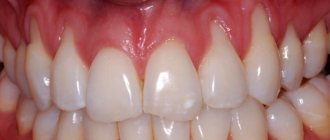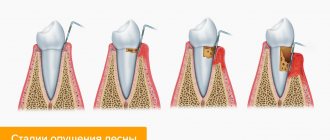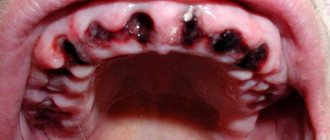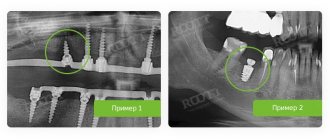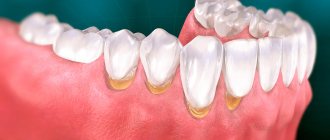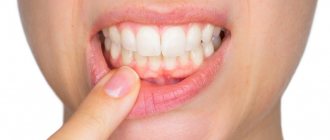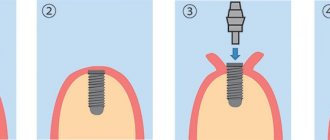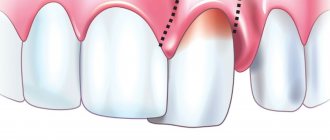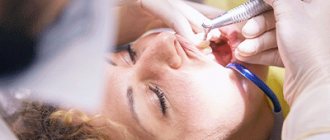Selective tooth grinding is a complex treatment method that is used for periodontal diseases. The procedure is used to correct occlusion and articulation on natural and artificial teeth, and allows you to evenly distribute the chewing load on the teeth. This is one of the most common methods in the complex therapy of periodontal diseases, which is used both in the initial and active stages of the pathological process.
Indications
Selective tooth grinding is a complex procedure that requires a strictly individual approach to each patient. In some cases, achieving an ideal ratio is impossible due to the structure of the jaw and individual teeth. In this case, the procedure is carried out in order to get as close as possible to the desired result.
The main purpose of grinding is to create uniform contact throughout the entire dentition, remove excessive load on the jaw and distribute it evenly over all teeth. To do this, hard tissues are ground off from the teeth that come into contact during chewing movements, after which they are aligned with the dentition, on which there are no points of contact.
Main indications for the procedure:
- improper closure of molars;
- increased tone of the masticatory muscles;
- displacement or deformation of the dentition due to injury;
- lack of natural tooth wear;
- abnormalities in the structure of the jaw;
- prevention of periodontal diseases.
In some cases, the grinding method is used to grind down sharp edges of teeth, which injure the tongue and oral mucosa. This saves the patient from minor injuries or damage.
Medical Internet conferences
Features of the method of selective grinding of teeth in patients with periodontal diseases.
Arakelyan E.Z., Vorobyova M.V., Pirverdiev E.A.
GBOU VPO Saratov State Medical University named after. V. I. Razumovsky Ministry of Health of Russia
Department of Orthopedic Dentistry
Key words : Selective grinding, occlusal load, supercontacts.
Relevance. The main goal of orthopedic treatment of patients with periodontal diseases is the restoration and normalization of the functional occlusal load on the periodontium of the affected teeth. Normalizing the occlusal load allows you to stabilize pathological processes in periodontal tissues and increase the effectiveness of surgical, therapeutic and orthopedic treatment.
Goals and objectives: to study methods for carrying out the stage of selective grinding in the clinic and the possibility of choosing them, taking into account the individual characteristics of the patient.
Materials and methods:
The main method of eliminating or reducing traumatic overload of teeth at the stage of orthopedic treatment is selective grinding of teeth. Many domestic and foreign authors offer their own options for this type of intervention. However, the following points are general and fundamental: the slopes of the tuberosities are subject to grinding, due to which the uniformity of movement of the lower jaw is disrupted and it moves to the side; the tops of the upper palatal and buccal lower cusps are not ground off, since they maintain the interalveolar height and ensure the stability of the central occlusion; the tops of the buccal upper and lingual lower cusps are not ground off, as they provide protection for the mucous membrane of the cheeks and protect the tongue from injury by the teeth; Grinding is carried out strictly in the direction from the gingival margin to the top of the cusp. The selective grinding procedure is usually carried out in 3-4 visits, at the end of each of which teeth polishing and remineralizing therapy are carried out. Carrying out the full volume of selective grinding in one step is considered impractical. Initially, the doctor identifies supercontacts using the occlusiography method, marks them and begins grinding. There are various systems and rules to designate premature contacts (MODU, BOLU, etc.), but most often at a clinical appointment the Jankelson classification is used, which is still considered the most convenient for use. The surfaces of the slopes of the tubercles are designated by Roman numerals I, II and III, and the corresponding surfaces of the antagonists as Ia, IIa and IIIa.
Class I includes premature contacts on the vestibular slopes of the buccal cusps of the lower molars and premolars and the vestibular surfaces of the lower anterior teeth; class I includes the oral slopes of the buccal cusps of the upper molars and premolars, as well as the oral surface of the upper anterior teeth. Class II - premature contacts on the oral slopes of the palatal cusps of the upper molars and premolars, class II a - vestibular slopes of the lingual cusps of the lower molars and premolars. Class III - premature contacts on the vestibular slopes of the palatal cusps of the upper molars and premolars, class III - oral slopes of the buccal cusps of the lower molars and premolars. At the clinical appointment, we used selective grinding techniques proposed by Jankelson, Schuyler, K.A. Kalamkarov, V.I. Pyanzin, A.D. Schwartz. and other authors.
The use of the Jankelson functional method makes it possible to eliminate supercontacts only in the position of central occlusion, since, according to the author, contact between the teeth of the upper and lower jaws during the act of chewing occurs only in the last stage of food processing, and in the remaining phases of the chewing cycle, tooth contact occurs through food lump In this case, the closure of the dentition is carried out independently by the patient in the most convenient position for him. Schyuler believed that in order to establish uniform occlusal contact between the dentition, it is necessary to grind, taking into account the lateral and anterior excursions of the lower jaw, since they are functional movements for the patient. The nature of the movements of the lower jaw and the volume of intervention are controlled manually by a doctor. Method of Kalamkarov H.A. allows you to eliminate all premature occlusal contacts, both during function and parafunction. This achieves the creation of simultaneous multiple contacts over the entire occlusal surface, which helps to stabilize the position of the lower jaw. A number of other authors, whose methods we studied, recommend selective grinding sequentially in the central, distal, anterior and lateral occlusions, controlling the closure of the dentition during various movements of the lower jaw.
When choosing a method for selective grinding, we took into account the patient’s age, the severity of periodontal damage, the severity of supercontacts, and the type of bite. In some patients it was carried out in full, in others locally on several “interested” teeth. Indications for selective grinding and the specifics of its implementation were determined after a clinical examination of the patient, study of his diagnostic models, survey radiographs and occlusiograms. Explanatory work was necessarily carried out with patients about the nature of this type of intervention, its therapeutic effect and safety for the patient. In some cases, to relieve pronounced psycho-emotional stress, patients were given medicinal preparation before the selective grinding procedure.
Results:
At the end of a course of selective grinding for a month, all patients experience stabilization of pathological processes in the periodontium due to the normalization of the occlusal load on the affected teeth, tooth mobility decreases, and the process of bone tissue resorption slows down. Data from an objective examination and the patient’s subjective feelings allow us to note a pronounced, lasting therapeutic effect after the manipulations.
Conclusions:
When planning selective grinding at a clinical appointment, the doctor should use all possible options for its implementation, taking into account the individual characteristics of the patient. These include: the age and general condition of the patient, the presence of concomitant pathology, the condition of the periodontal tissues at the time of the initial examination and over time, the presence and severity of supercontacts in various parts of the dentition, the type of bite, the nature of the movements of the lower jaw, the condition of the hard tissues of the teeth and many others important factors. A comprehensive method of selective grinding should be carried out after analyzing all examination data, taking into account the individual characteristics of the dental system and the general health of the patient, which allows the doctor to achieve a pronounced therapeutic effect from the treatment.
Contraindications
Sanding is not carried out in the following cases:
- During the period of progressive periodontal inflammation. In this case, before the main procedure, the patient is prescribed a course of treatment.
- The patient has been diagnosed with dental anomalies and deformations that require treatment by other specialists (orthopedist or surgeon).
- Acute and chronic diseases of the temporomandibular joint are observed.
The grinding procedure should only be carried out by a qualified specialist. Incorrectly performed correction can lead to displacement of teeth, excessive load on the periodontium due to flattening of the dental tubercle, and removal of one or more teeth from occlusal contact.
Contraindications for grinding
The selective grinding technique also has contraindications:
- Severe inflammatory process of periodontal tissues. This is a relative contraindication. Before grinding, anti-inflammatory therapy is carried out, dental plaque is removed, and foci of the infectious process are eliminated. After this, sanding is performed.
- TMJ pathologies of acute and chronic course, which are accompanied by dysfunction and pain. In this case, grinding can be performed only during the period of subsidence of symptoms, during remission.
- Severe deformations and anomalies of the dental system, when surgical, orthodontic or complex treatment is required.
How does the procedure work?
The operation is carried out in several stages, with short breaks.
Preparation for the procedure is based on a preliminary visual examination of the patient. Closing the dentition helps to identify points of contact between the dental surface and the arch where this closure is absent. Next, final (more accurate) testing is done using carbon paper to identify all problem areas for further occlusion correction.
Based on the data obtained, zones for grinding are selected. The procedure itself may seem unpleasant, so it is usually carried out under the influence of an anesthetic. A preliminary test for allergic reactions eliminates all negative consequences from the use of painkillers.
The grinding procedure is carried out in three stages:
- At the first stage, a preliminary grinding procedure is carried out in order to eliminate the most pronounced unevenness of the dental surfaces. In case of significant shortening of teeth, mandatory depulpation is carried out.
- Next, the procedure is carried out on other teeth that require correction.
- After final polishing, fluoride-containing polishing pastes are used.
After each stage, treatment is carried out with special preparations that reduce tooth sensitivity.
Why do the necks of teeth become exposed? About gum recession...
Today I would like to publish an article by my colleague Oleg Yuryevich Ponomarev about the causes and methods of eliminating a common problem - exposure of the necks of teeth ( gingival recession ).
So, a young, beautiful girl came to me, whose smile was marred by gum recession on tooth 2.3 or on the upper canine on the left side.
Of course, people wonder: why did the gums disappear? Perhaps the body lacks some vitamins? Or, as they say, you need to check your thyroid gland?
In fact, if we turn to foreign literature, in which the problem was thoroughly studied back in the 70s of the last century, it becomes clear that the main triggering factor for recessions is traumatic oral hygiene. Simply put, the girl brushes her teeth too hard and with the wrong movements. To this main reason may be added a number of accompanying factors that are determined by our individual characteristics.
1. Too external position of the tooth root in the bone.
2. “Thin gums”
3. A small amount of motionless, so-called. “keratinized” gum directly next to the tooth.
4. The presence of abnormally attached cords and frenulums that can pull poorly attached tissues away from the tooth.
These are, perhaps, all the main causes of gum recession. Based on the reasons, it is necessary to find approaches to solving the problem. We identified a number of factors that caused the recession in this patient:
1. Toothbrush injury. A hygiene lesson was taught and the correct “sweeping” movements that should be used to brush teeth were shown.
2. Vestibular position of the tooth root - we cannot do anything about this problem without the help of an orthodontist, and it is not so easy to move just one tooth without disturbing the established balance of the dental system.
3. Thin biotype of the oral mucosa.
4. Small amount of keratinized gum.
We will work on problems 3. and 4.:
Using a special tunnel technique (without visible incisions), I placed a connective tissue flap under the gum, which I received on the palate, also using the atraumatic, tunnel technique of one incision. This very delicate work requires the surgeon to have high manual skills and knowledge of microsurgery. A connective tissue graft from the palate solves two problems at once - it “thickens the gum” in this place and, due to the presence of gingival cells within itself, causes gradual keratinization in the grafting area. Simultaneously with the grafting, the gums were displaced in order to cover the exposed root. Everything is secured with just one seam. A week later the girl came to the reception:
We see that the graft has taken root, but slight hyperemia of the gums remains. This is a normal situation; active growth of blood vessels occurs. Once again recommendations on hygiene and we say goodbye for 6 months.
Macro photographs clearly show a slightly thickened contour of the gums in the canine area. The recession is completely closed. The connective tissue graft caused additional keratinization of the gums and will provide a stable result. It’s nice to see a good result and hear sincere gratitude from the patient. The inspection took only a couple of minutes, necessary for the photo protocol.
Author of the clinical case: implant surgeon Oleg Ponomarev
Possible complications
If the rules for the procedure are not followed, the following complications are possible:
- decrease in interalveolar height;
- tooth displacement;
- hyperesthesia of hard tissues;
- excessive load on the periodontium after flattening the cusps of the teeth;
- removal of some teeth from occlusal contact and overload of the periodontium of others.
Therefore, the procedure can only be trusted to a dentist who has undergone special training and has the appropriate qualifications.
Duration of treatment
Correcting crowding at the level of teeth and dentition takes from six months to two years, depending on the complexity of the clinical case. It is better to normalize the position and size of the jaws from childhood - with proper treatment, this will take no more than six months. In adults, it will not be possible to correct bone curvatures only with the help of orthodontic treatment - you will have to seek help from surgeons.
Interesting fact!
Typically, orthodontic treatment is performed on both jaws; in rare cases with slight crowding, treatment can be performed on one jaw.
